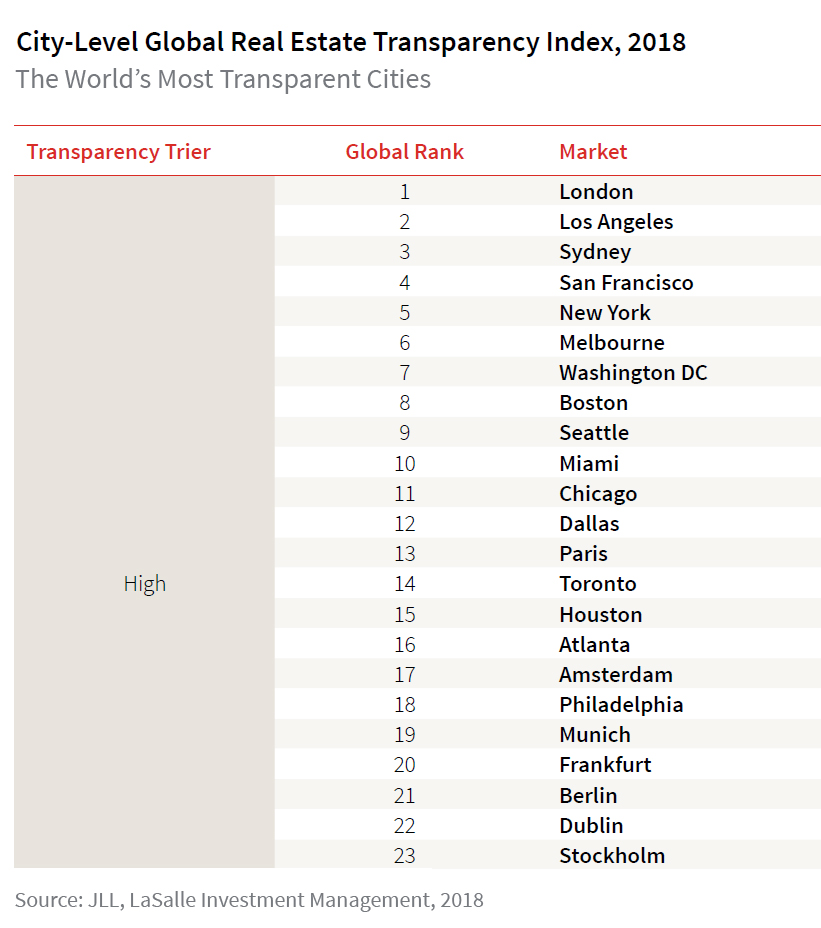
Photo: shutterstock_455647135
Real estate transparency–a key ingredient of a successful city
30 July 2018
There is increasing recognition that the real estate industry can act as one of the fundamental drivers of a city’s success, contributing to a more competitive, efficient and flexible environment for businesses and communities. The sector plays a key role in transforming neighbourhoods, in providing productive spaces in which citizens can live and work, and in attracting new businesses and investment into cities.
In order to fulfill this role and operate efficiently and succesfully, the real estate sector requires high levels of transparency. The concept of transparency can cover a broad range of areas, from regulatory frameworks to in-depth market information, and allows for standardised, clear and fair practices. This foundation allows businesses and investors to make decisions with confidence, while enabling governments to function effectively. High-quality property market data, for example, sends developers and investors a clear signal about when and what types of space to build. Moreover, data on environmental sustainability enables businesses to make informed choices and helps cities on the path to a more sustainable future. Real estate market transparency is one of the key attributes, therefore, of a successful, future-ready city.

The world’s most transparent cities
The 2018 edition of the biennial Global Real Estate Transparency Index, compiled jointly by JLL & LaSalle Investment Management, reveals the level of transparency across 158 metropolitan real estate markets. London comes out on top as the world’s most transparent city, followed by Los Angeles, Sydney and San Francisco.
These ‘Highly Transparent’ anglophone markets are among the most favoured destinations for real estate investors, thanks in part to their transparent operating environments. Overall, ‘Highly Transparent’ markets–across 11 countries–account for around 75 percent of global direct real estate investment.
Of the world’s top 30 cities for real estate investment, only two–the Chinese megacities of Shanghai and Beijing –remain in the ‘Semi-Transparent’ tier of our city rankings. These and other major cities in China, India, and Brazil, are on the cusp of the ‘Transparent’ category, although additional reforms will be crucial in pushing these markets up the Index.
Structural changes and major disruption within the real estate industry mean that even the leading markets are seeing transparency tested by new challenges, with standards being pushed ever higher by rising expectations from investors, occupiers and the public. The proptech sector–the meeting point between real estate and new technologies–is often seen as the next major breakthrough for transparency, as new forms of data are created, collected and collated and new tools bring clarity to complex processes. The booming ‘co-working’ sector is also bringing new business models to the real estate industry. In both cases, there are question marks about how a traditional industry will absorb change and respond to disruption, as well about the impact on real estate transparency.
City-level transparency varies within national markets
The 2018 Global Real Estate Transparency Index reveals both the city transparency differences between countries and city transparency differences within the same country. Access to robust, reliable and comprehensive market and investment performance tracking data is key for overall real estate transparency and accounts for the largest differentiation between markets within the same country. Data availability drops off rapidly in secondary and tertiary cities, as well as across sectors, in many countries. However, as investors and occupiers broaden their coverage, market fundamentals data is continuing to improve in non-primary cities and submarkets.
In some countries, transparency levels are consistent–notably in those nations with well-established real estate markets with lengthy time-series data available, including the UK, Germany, Canada and Australia. However, other markets show a wider divergence between cities. For example, market information in France and Japan is much more limited outside of Paris and Tokyo. Large polycentric countries like China and the United States have significant variation between cities. In the US, a patchwork of state and municipal governments leads to differences in transaction disclosure rules and taxation, compounding the effects of distinct market practices and data availability across metropolitan areas.
Real estate transparency is clearly an important differentiating factor in the increasingly competitive landscape of global cities. Cities give themselves an advantage over their peers by providing transparent, open and well-managed environments in which citizens, businesses and investors have the ability to operate with confidence. And, competition aside, higher levels of real estate transparency function as a positive force, promoting development and economic growth.
As expectations for higher standards and greater transparency continue to rise, industry, investors, and governments in successful cities can work together to keep pace with global progress toward a more transparent property sector.
To find out more about Global Real Estate Transparency and to see where individual markets rank, visit:http://www.jll.com/greti








